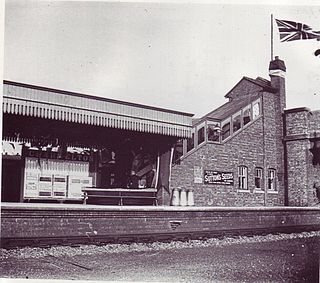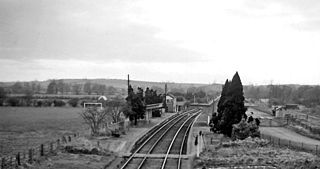
Hook Norton is a village and civil parish in Oxfordshire, England. It lies 4+1⁄2 miles (7 km) northeast of Chipping Norton, close to the Cotswold Hills. The 2011 Census recorded the parish's population as 2,117. The village is formed of four neighbourhoods: East End, Scotland End, Down End and Southrop.
The Wrexham and Minera Railway or Wrexham and Minera Branch was a railway line in North Wales between the city of Wrexham, the village of Brymbo where it served the Brymbo Steelworks, and the lead mines and limeworks at Minera. A further branch ran from Brymbo to Coed Talon, where it connected with lines to Mold. The system was constructed in several stages between 1844 and 1872, while the various lines making up the system closed in 1952, 1972 and 1982.

Kings Sutton railway station serves the village of King's Sutton in Northamptonshire, England. It is also one of the nearest railway stations to the town of Brackley. The station is managed by Chiltern Railways, who provide most of the services, including from London Paddington and Marylebone to Oxford and Banbury.

Kingham railway station in Oxfordshire, England, is between the Oxfordshire village of Kingham and the Gloucestershire village of Bledington, to which it is closer. It is also the closest station to the town of Chipping Norton.
The Oxford, Worcester and Wolverhampton Railway (OW&WR) was a railway company in England. It built a line from Wolvercot Junction near Oxford to Worcester, Stourbridge, Dudley and Wolverhampton, as well as some branches.
The Hook Norton ironstone quarries (Brymbo) were ironstone quarries near Hook Norton in Oxfordshire, England. The quarries were in operation from 1899 to 1946 supplying ironstone to the Brymbo Steelworks in Wrexham and were served by the Brymbo Ironworks Railway, an extensive, 2 ft (610 mm) narrow gauge industrial railway.

Charwelton railway station was a station at Charwelton in Northamptonshire on the former Great Central Railway main line, the last main line to be built from the Northern England to London. The station opened with the line on 15 March 1899.
Andoversford Junction railway station was in Gloucestershire on the Great Western Railway's Banbury and Cheltenham Direct Railway that opened in 1881. Situated about six miles east of Cheltenham, the station served the village of Andoversford with its large market, which provided much of the traffic at the station.
The Banbury and Cheltenham Direct Railway (B&CDR) was a railway company through the Cotswolds in England that built a line between points near Banbury and Cheltenham. Its principal objective, as well as a general rural rail service, was the conveyance of iron ore from the East Midlands to South Wales.
Sarsden Halt was an unstaffed railway station on the Banbury and Cheltenham Direct Railway.

Milton Halt railway station is a former railway station that served the village of Milton in northern Oxfordshire, England.

Bloxham railway station served the village of Bloxham in northern Oxfordshire, England.
Rollright Halt railway station served the village of Great Rollright in Oxfordshire, England.

Chipping Norton railway station served the town of Chipping Norton, Oxfordshire, England. The station had two platforms and a signal box.

The Chipping Norton Railway opened in 1855, first linking the town of Chipping Norton with the Oxford, Worcester and Wolverhampton Railway (OW&W) at Kingham station, with a single station in the form of Sarsden Halt initially located on the route.

Kerne Bridge railway station is a disused railway station on the Ross and Monmouth Railway constructed in the Herefordshire hamlet of Kerne Bridge which also served the village of Goodrich across the River Wye.
The Hook Norton Ironstone Partnership was the first company to quarry ironstone at Hook Norton on a large scale. Although only in operation for twelve years, its quarries subsequently became part of the Brymbo Steelworks quarries and relics of the Partnership's railways and tramways can still be seen today.
The Hook Norton ironstone quarries (Baker) were ironstone quarries at Hook Norton, Oxfordshire, England, operating from the 1890s to the end of the First World War. Two sites were quarried and it was the only Hook Norton ironstone quarry business to be locally owned.
Eric Tonks was an English writer and historian of British industrial railways. He is regarded as one of the pioneers of the industrial archaeology of railways and quarrying. He was also a noted Jazz discographer.

Shipston-on-Stour railway station was a railway station which served the town of Shipston-on-Stour, Warwickshire. It was the terminus of the Shipston-on-Stour branch.










